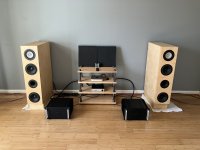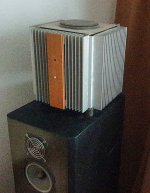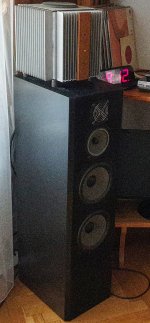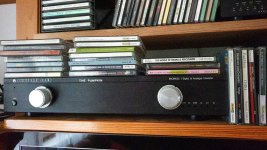For a crippled F4 the voltage limits of the input jfets would not be an issue. But what is the limitation of the bias voltage regulator 431?Also, at +/-32V you should consider the dissipation and voltage limits of the input jfets.
https://www.ti.com/lit/gpn/tl431
Table 7.1, first line, parameter “Vka”. Make sure to read note (2).
Remember that in this amplifier the TL431 is floating between the rails and has somewhat-large value resistors as well.
The 431 is only trying to output the voltage sufficient to turn the mosfets on and bias them up a little.
Table 7.1, first line, parameter “Vka”. Make sure to read note (2).
Remember that in this amplifier the TL431 is floating between the rails and has somewhat-large value resistors as well.
The 431 is only trying to output the voltage sufficient to turn the mosfets on and bias them up a little.
Thanks @6L6
37V and protected by the zeners i guess.
Anyway, doubt it would be experienced as more dynamic with increased rail voltage at my usual listening levels below 1watt.
Suppose any improvements should be focused on what is in front of this amp.
But if sometimes needing more than 25w, then it would be interesting to experiment,,
37V and protected by the zeners i guess.
Anyway, doubt it would be experienced as more dynamic with increased rail voltage at my usual listening levels below 1watt.
Suppose any improvements should be focused on what is in front of this amp.
But if sometimes needing more than 25w, then it would be interesting to experiment,,
The voltage across tl431 will be the combined Vgs of the N and P channel mosfets. About 9-10V. Higher rails won’t change that.
So for a crippled F4 the disadvantage of higher rails would be more expensive psu-caps?
But I suppose one would need a preamp that can swing serious voltage in order to take advantage of higher rails,,
But I suppose one would need a preamp that can swing serious voltage in order to take advantage of higher rails,,
Yup, one option is the Impasse pre which was made to be used with the F-4 and is great, but it will be nice to see what other candidates people here mention
I got an O-scope and an 8 Ohm, 300W dummy load. Need to revisit the test we did on the F6s now that I have the F4s fully functioning.With a pair of F4, connected as monoblocks, you can get 100WPC easily from stock PSU voltages.
Attachments
Hello!
Long time no see...
I don't remember why I used balanced XLR interconnects between the preamp and power amplifiers when building more then 20 years ago my audio system. Probably because I wanted to be more professional.
I recently experimented with bi-wiring between the F4s and the loudspeakers - I used a LAN cable to power the midrange and tweeters. The sound has improved a bit. It is true that I found a video in which a guy destroys the myth of bi-wiring quite logically explaining why it does nothing. For me it worked because the LAN cable is better for medium and especially high frequencies.
And now it turns out that all this doesn't make sense because I got even better results in the following way:
I significantly shortened the speaker cables (I gave up bi-wiring) from 7 meters to 1 meter, and as interconnects between the F4 and the PUMPKIN preamp I used 10 meters long XLR cables. I put the F4 monoblocks on the columns, which certainly won't please my wife. As a result, the equipment clearly gained a new quality - more details, a deeper stage. The sound got a bit too aggressive, but it's enough to turn it down a bit. I have two Chesky test CDs and enjoy listening to test samples that demonstrate stage depth. And the rain test - now it's like pouring from the sky and splashing on the floor in the room. I hope I didn't say it at the wrong time because once the neighbors flooded us twice. And on the beginning, when I started with the equipment, this test was an annoying rattle.
And these changes are thanks to the video titled:
Long interconnects or speaker cables?
Very nice Mr. Paul McGowan, PS Audio, describes responding to mail inquiries.
I used to think about such a solution, but where to get long XLR cables quickly... Well, for several years I have had two for microphone recordings. I exercised last night carrying amplifiers and pulling cables, today all my bones hurt (I am 73). The space on the shelf where the monoblocks stood became free. Maybe I'll put a turntable there. I still need to remove the old wiring.
And I have to buy new cables and XLR connectors to have microphones, but that can wait because I won't be going to the countryside until May to record ambient and bats voices.
Best Regards,
Andrzej Sochon
Long time no see...
I don't remember why I used balanced XLR interconnects between the preamp and power amplifiers when building more then 20 years ago my audio system. Probably because I wanted to be more professional.
I recently experimented with bi-wiring between the F4s and the loudspeakers - I used a LAN cable to power the midrange and tweeters. The sound has improved a bit. It is true that I found a video in which a guy destroys the myth of bi-wiring quite logically explaining why it does nothing. For me it worked because the LAN cable is better for medium and especially high frequencies.
And now it turns out that all this doesn't make sense because I got even better results in the following way:
I significantly shortened the speaker cables (I gave up bi-wiring) from 7 meters to 1 meter, and as interconnects between the F4 and the PUMPKIN preamp I used 10 meters long XLR cables. I put the F4 monoblocks on the columns, which certainly won't please my wife. As a result, the equipment clearly gained a new quality - more details, a deeper stage. The sound got a bit too aggressive, but it's enough to turn it down a bit. I have two Chesky test CDs and enjoy listening to test samples that demonstrate stage depth. And the rain test - now it's like pouring from the sky and splashing on the floor in the room. I hope I didn't say it at the wrong time because once the neighbors flooded us twice. And on the beginning, when I started with the equipment, this test was an annoying rattle.
And these changes are thanks to the video titled:
Long interconnects or speaker cables?
Very nice Mr. Paul McGowan, PS Audio, describes responding to mail inquiries.
I used to think about such a solution, but where to get long XLR cables quickly... Well, for several years I have had two for microphone recordings. I exercised last night carrying amplifiers and pulling cables, today all my bones hurt (I am 73). The space on the shelf where the monoblocks stood became free. Maybe I'll put a turntable there. I still need to remove the old wiring.
And I have to buy new cables and XLR connectors to have microphones, but that can wait because I won't be going to the countryside until May to record ambient and bats voices.
Best Regards,
Andrzej Sochon
Attachments
Last edited:
A wonderful setup. Somewhere here, I've got to finalize the speaker positioning then do the same, swap out the long speaker cable runs for some 2 foot ones.
I used to run my F4 in my main system as a pair of mono blocks with an Impass, more recently I have been just using one with ASKA Lender preamp (40v output) to drive a pair of Frugal horns in my office. That combination sounds exemplary, Mr Pass stated he felt the F4 current source worked quite well with full range drivers and I have to agree with him.
How could that be when your speakers need at least 20 wpc, and driven with 2V the F4 couldn't output anywhere near that?One of things I drive drive my F4 with is a dac with a grounded grid amplifier (12AU7) putting out a measly 2V. For me it’s plenty with most program material driving a Martin Logan ELS (Montis).
https://www.martinlogan.com/en/product/montis
My new speakers will be at least 93db/w/m and will probably never fall below 7 ohms, if that low. My room is 2880 cu ft. The speakers only play down to 70Hz, below which my powered subs take over. The Aikido preamp will drive my stock F4. And I can't imagine playing the mains louder than between 40 and 50 phons @ 1kHz. https://en.wikipedia.org/wiki/Equal-loudness_contour How far away is the factory bias on a stock F4 for minimal distortion if the speakers only need ~ 6 wpc?Yes,it’s magic.
Surely you have seen the F4 build guide.
Se the four rules on the page.
Distortion figures vary with bias so it would sound even better with more bias with “sweet spot was closer to 300mV bias”
I have 0.27V bias with 5u-300 heat sinks.
You must have fantastic speakers to drive them with no gain? I have tried it but preferred to change pre to +6db.
Good luck tweaking.
Recommended bias is usually right in the sweet spot. You can increase if you have heatsink to spare. It will make no difference in output power.
Luckily I got 6 pairs NOS Hitachi SK133/SJ48 for cheap.
Is it possible to build up the F4 with those Mosfets?
Is something to consider when integrate the Hitachis into the F4 ?
Is it possible to build up the F4 with those Mosfets?
Is something to consider when integrate the Hitachis into the F4 ?
Absolutely. Also you can reduce the values of source resistors with Laterals.
🙂
🙂
- Home
- Amplifiers
- Pass Labs
- F4 power amplifier




